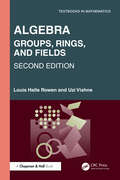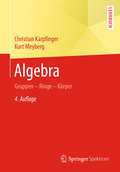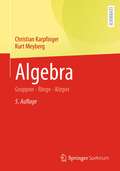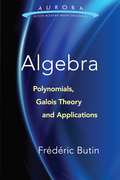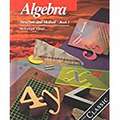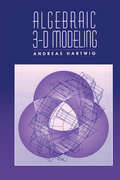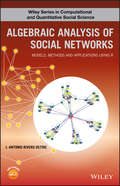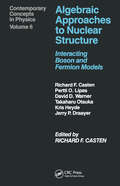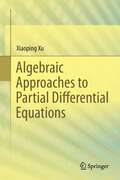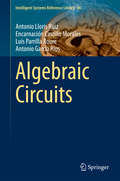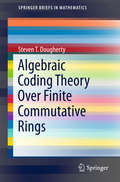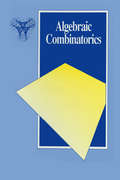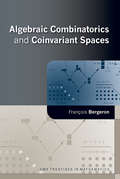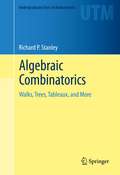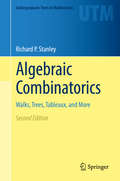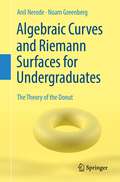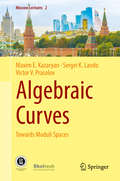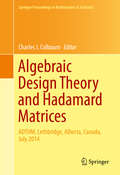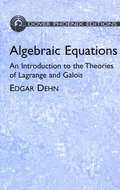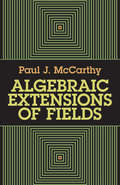- Table View
- List View
Algebra: Groups, Rings, and Fields (Textbooks in Mathematics)
by Louis Halle Rowen Uzi VishneAlgebra is a subject we have become acquainted with during most of our mathematical education, often in connection with the solution of equations. Algebra: Groups, Rings, and Fields, Second Edition deals with developments related to their solutions.The principle at the heart of abstract algebra, a subject that enables one to deduce sweeping conclusions from elementary premises, is that the process of abstraction enables us to solve a variety of such problems with economy of effort. This leads to the glorious world of mathematical discovery.This second edition follows the original three-pronged approach: the theory of finite groups, number theory, and Galois’ amazing theory of field extensions tying solvability of equations to group theory.As algebra has branched out in many directions, the authors strive to keep the text manageable while at the same time introducing the student to exciting new paths. In order to support this approach, the authors broadened the first edition, giving monoids a greater role, and relying more on matrices. Hundreds of new exercises were added.A course in abstract algebra, properly presented, could treat mathematics as an art as well as a science. In this exposition, we try to present underlying ideas, as well as the results they yield.
Algebra: Groups, Rings, and Fields (Textbooks in Mathematics)
by Louis RowenThis text presents the concepts of higher algebra in a comprehensive and modern way for self-study and as a basis for a high-level undergraduate course. The author is one of the preeminent researchers in this field and brings the reader up to the recent frontiers of research including never-before-published material. From the table of contents: - Groups: Monoids and Groups - Cauchyís Theorem - Normal Subgroups - Classifying Groups - Finite Abelian Groups - Generators and Relations - When Is a Group a Group? (Cayley's Theorem) - Sylow Subgroups - Solvable Groups - Rings and Polynomials: An Introduction to Rings - The Structure Theory of Rings - The Field of Fractions - Polynomials and Euclidean Domains - Principal Ideal Domains - Famous Results from Number Theory - I Fields: Field Extensions - Finite Fields - The Galois Correspondence - Applications of the Galois Correspondence - Solving Equations by Radicals - Transcendental Numbers: e and p - Skew Field Theory - Each chapter includes a set of exercises
Algebra: Gruppen - Ringe - Körper
by Christian Karpfinger Kurt MeybergDieses vierfarbige Lehrbuch wendet sich an Studierende der Mathematik in Bachelor- und Lehramts-Studieng#65533;ngen. Es bietet in einem Band ein lebendiges Bild der mathematischen Inhalte, die #65533;blicherweise im ersten Studienjahr behandelt werden (und etliches mehr). Mathematik-Studierende finden wichtige Begriffe, S#65533;tze und Beweise ausf#65533;hrlich und mit vielen Beispielen erkl#65533;rt und werden an grundlegende Konzepte und Methoden herangef#65533;hrt. Im Mittelpunkt stehen das Verst#65533;ndnis der mathematischen Zusammenh#65533;nge und des Aufbaus der Theorie sowie die Strukturen und Ideen wichtiger S#65533;tze und Beweise. Es wird nicht nur ein in sich geschlossenes Theoriengeb#65533;ude dargestellt, sondern auch verdeutlicht, wie es entsteht und wozu die Inhalte sp#65533;ter ben#65533;tigt werden. Herausragende Merkmale sind: durchg#65533;ngig vierfarbiges Layout mit mehr als 600 Abbildungen pr#65533;gnant formulierte Kerngedanken bilden die Abschnitts#65533;berschriften Selbsttests in kurzen Abst#65533;nden erm#65533;glichen Lernkontrollen w#65533;hrend des Lesens farbige Merkk#65533;sten heben das Wichtigste hervor ,,Unter-der-Lupe"-Boxen zoomen in Beweise hinein, motivieren und erkl#65533;ren Details ,,Hintergrund-und-Ausblick"-Boxen stellen Zusammenh#65533;nge zu anderen Gebieten und weiterf#65533;hrenden Themen her Zusammenfassungen zu jedem Kapitel sowie #65533;bersichtsboxen mehr als 400 Verst#65533;ndnisfragen, Rechenaufgaben und Aufgaben zu Beweisen deutsch-englisches Symbol- und Begriffsglossar Der inhaltliche Schwerpunkt liegt auf den Themen der Vorlesungen Analysis 1 und 2 sowie Linearer Algebra 1 und 2. Behandelt werden dar#65533;ber hinaus Inhalte und Methodenkompetenzen, die vielerorts im ersten Studienjahr der Mathematikausbildung vermittelt werden. Auf der Website zum Buch www. matheweb. de finden Sie Hinweise, L#65533;sungswege und Ergebnisse zu allen Aufgaben Zusatzmaterialien wie Maple-Worksheets zu verschiedenen Themen des Buchs die M#65533;glichkeit, zu den Kapiteln Fragen zu stellen Das Buch wird allen Studierenden der Mathematik vom Beginn des Studiums bis in h#65533;here Semester hinein ein verl#65533;sslicher Begleiter sein.
Algebra: Gruppen - Ringe - Körper
by Christian Karpfinger Kurt MeybergDieses Lehrbuch zur Algebra bietet eine Einführung in die grundlegenden Begriffe und Methoden der modernen Algebra. Es werden die Themen eines Grundkurses zur Algebra ausführlich und motivierend behandelt. Die Algebra wird von vielen Studierenden als sehr abstrakt empfunden. Daher haben sich die Autoren bemüht, die Ergebnisse und Begriffe mit zahlreichen Beispielen zu unterlegen. Die Beweisführungen sind ausführlich, die Kapitel sind in kleine Lerneinheiten unterteilt. Diese Lerneinheiten führen Schritt für Schritt an die Ergebnisse heran und können durch diese Darstellung vom Leser besser nachvollzogen werden. Die zahlreichen Aufgaben unterschiedlicher Schwierigkeitsgrade zum Ende der Kapitel überprüfen das Gelernte und fördern das tiefere Verständnis der Theorie. Das Buch wurde für die 5. Auflage vollständig durchgesehen und um einen ausführlichen Abschnitt zum semidirekten Produkt von Gruppen erweitert. Zudem wurden Lösungsmethoden inklusive Beispiele für manche typischen Aufgabenstellungen übersichtlich zusammengestellt, z.B. zum Nachweis der Reduzibilität bzw. Irreduzibilität von Polynomen.
Algebra: Gruppen – Ringe – Körper
by Christian KarpfingerDieses Lehrbuch zur Algebra bietet eine Einführung in die grundlegenden Begriffe und Methoden der modernen Algebra. Es werden die Themen eines Grundkurses zur Algebra ausführlich und motivierend behandelt.Die Algebra wird von vielen Studierenden als sehr abstrakt empfunden. Daher hat sich der Autor bemüht, die Ergebnisse und Begriffe mit zahlreichen Beispielen zu unterlegen. Die Beweisführungen sind ausführlich, gelegentlich werden sogar verschiedene Beweise aufgezeigt. Die Kapitel sind in kleine Lerneinheiten unterteilt. Diese Lerneinheiten führen Schritt für Schritt an die Ergebnisse heran und können durch diese Darstellung vom Leser besser nachvollzogen werden. Der Autor hat stets darauf geachtet, dass erst dann neue Begriffe und Konzepte eingeführt werden, wenn ein gewisses Vertrauen im Umgang mit den bis dahin entwickelten Begriffen und Konzepten besteht. Das Vorgehen wird stets motiviert, schwierige Sachverhalte werden ausführlich erklärt und an Beispielen erprobt. DieLeser erhalten dadurch einen einfachen Zugang zu dem nicht ganz leichten Thema der Algebra.Die zahlreichen Aufgaben unterschiedlicher Schwierigkeitsgrade zum Ende der Kapitel überprüfen das Gelernte und fördern das tiefere Verständnis der Theorie. Das Buch wurde für die 6. Auflage vollständig durchgesehen und um zwei Beweise des quadratischen Reziprozitätsgesetzes ergänzt. Zudem erhalten Sie Zugang auf 300 Flashcards (Springer-Nature-Flashcards-App), mit denen Sie Ihr Verständnis der Theorie auf spielerische Weise testen und einüben können.
Algebra: Polynomials, Galois Theory and Applications
by Frédéric ButinSuitable for advanced undergraduates and graduate students in mathematics and computer science, this precise, self-contained treatment of Galois theory features detailed proofs and complete solutions to exercises. Originally published in French as Algèbre — Polynômes, théorie de Galois et applications informatiques, this 2017 Dover Aurora edition marks the volume's first English-language publication.The three-part treatment begins by providing the essential introduction to Galois theory. The second part is devoted to the algebraic, normal, and separable Galois extensions that constitute the center of the theory and examines abelian, cyclic, cyclotomic, and radical extensions. This section enables readers to acquire a comprehensive understanding of the Galois group of a polynomial. The third part deals with applications of Galois theory, including excellent discussions of several important real-world applications of these ideas, including cryptography and error-control coding theory. Symbolic computation via the Maple computer algebra system is incorporated throughout the text (though other software of symbolic computation could be used as well), along with a large number of very interesting exercises with full solutions.
Algebra: Structure and Method, Book 1
by Richard G. Brown Mary P. Dolciani Robert H. Sorgenfrey William L. ColeAn algebra book requires a different type of reading than a novel or a short story. Every sentence in a math book is full of information and logically linked to the surrounding sentences. You should read the sentences carefully and think about their meaning.
Algebra: Structure and Method, Book 1
by Richard G. Brown Mary P. Dolciani Robert H. Sorgenfrey William L. ColeAlgebra, Structure and Method textbook for ninth grade students.
Algebra: The Easy Way to Learn Algebra
by Hugh NeillAlgebra: A Complete Introduction is the most comprehensive yet easy-to-use introduction to using Algebra.Written by a leading expert, this book will help you if you are studying for an important exam or essay, or if you simply want to improve your knowledge. The book covers all the key areas of algebra including elementary operations, linear equations, formulae, simultaneous equations, quadratic equations, logarithms, variation, laws and sequences.Everything you will need is here in this one book. Each chapter includes not only an explanation of the knowledge and skills you need, but also worked examples and test questions.Chapter 1: The meaning of algebraChapter 2: Elementary operations in algebraChapter 3: Brackets and operations with themChapter 4: Positive and negative numbersChapter 5: Equations and expressionsChapter 6: Linear equationsChapter 7: FormulaeChapter 8: Simultaneous equationsChapter 9: Linear inequalitiesChapter 10: Straight-line graphs; coordinatesChapter 11: Using inequalities to define regionsChapter 12: Multiplying algebraical expressions Chapter 13: FactorsChapter 14: FractionsChapter 15: Graphs of quadratic functionsChapter 16: Quadratic equationsChapter 17: IndicesChapter 18: LogarithmsChapter 19: Ratio and proportionChapter 20: VariationChapter 21: The determination of lawsChapter 22: Rational and irrational numbers and surdsChapter 23: Arithmetical and geometric sequences
Algebraic 3-D Modeling
by Andreas HartwigWritten for researchers and developers of three-dimensional modeling programs, this book examines the variety of existing systems while investigating the practical limitations of available software. From the table of contents: - Polyhedra - Boundary Models - A Small Language Modeler - The Algebraic Model - Computation of Algebraic Manifolds - Topol
Algebraic Analysis of Social Networks: Models, Methods and Applications Using R (Wiley Series in Computational and Quantitative Social Science)
by J. Antonio OstoicPresented in a comprehensive manner, this book provides a comprehensive foundation in algebraic approaches for the analysis of different types of social networks such as multiple, signed, and affiliation networks. The study of such configurations corresponds to the structural analysis within the social sciences, and the methods applied for the analysis are in the areas of abstract algebra, combinatorics, and graph theory. Current research in social networks has moved toward the examination of more realistic but also more complex social relations by which agents or actors are connected in multiple ways. Addressing this trend, this book offers hands-on training of the algebraic procedures presented along with the computer package multiplex, written by the book’s author specifically to perform analyses of multiple social networks. An introductory section on both complex networks and for R will feature, however the subjects themselves correspond to advanced courses on social network analysis with the specialization on algebraic models and methods.
Algebraic Approaches to Nuclear Structure
by A. CastenholzThis book is devoted to algebraic models and their applications. It presents a simple, but thorough, pedagogic approach, starting from the most elementary ideas and building up to the most recent results of advanced theories. The book is designed for a graduate level treatment.
Algebraic Approaches to Partial Differential Equations (Springer Monographs in Mathematics)
by Xiaoping XuThis book presents the various algebraic techniques for solving partial differential equations to yield exact solutions, techniques developed by the author in recent years and with emphasis on physical equations such as: the Maxwell equations, the Dirac equations, the KdV equation, the KP equation, the nonlinear Schrodinger equation, the Davey and Stewartson equations, the Boussinesq equations in geophysics, the Navier-Stokes equations and the boundary layer problems. In order to solve them, I have employed the grading technique, matrix differential operators, stable-range of nonlinear terms, moving frames, asymmetric assumptions, symmetry transformations, linearization techniques and special functions. The book is self-contained and requires only a minimal understanding of calculus and linear algebra, making it accessible to a broad audience in the fields of mathematics, the sciences and engineering. Readers may find the exact solutions and mathematical skills needed in their own research.
Algebraic Circuits (Intelligent Systems Reference Library #66)
by Antonio Lloris Ruiz Encarnación Castillo Morales Luis Parrilla Roure Antonio García RíosThis book presents a complete and accurate study of algebraic circuits, digital circuits whose performance can be associated with any algebraic structure. The authors distinguish between basic algebraic circuits, such as Linear Feedback Shift Registers (LFSRs) and cellular automata and algebraic circuits, such as finite fields or Galois fields. The book includes a comprehensive review of representation systems, of arithmetic circuits implementing basic and more complex operations and of the residue number systems (RNS). It presents a study of basic algebraic circuits such as LFSRs and cellular automata as well as a study of circuits related to Galois fields, including two real cryptographic applications of Galois fields.
Algebraic Coding Theory Over Finite Commutative Rings (SpringerBriefs in Mathematics)
by Steven T. DoughertyThis book provides a self-contained introduction to algebraic coding theory over finite Frobenius rings. It is the first to offer a comprehensive account on the subject. Coding theory has its origins in the engineering problem of effective electronic communication where the alphabet is generally the binary field. Since its inception, it has grown as a branch of mathematics, and has since been expanded to consider any finite field, and later also Frobenius rings, as its alphabet. This book presents a broad view of the subject as a branch of pure mathematics and relates major results to other fields, including combinatorics, number theory and ring theory. Suitable for graduate students, the book will be of interest to anyone working in the field of coding theory, as well as algebraists and number theorists looking to apply coding theory to their own work.
Algebraic Combinatorics (Chapman Hall/crc Mathematics Ser. #6)
by Chris GodsilThis graduate level text is distinguished both by the range of topics and the novelty of the material it treats--more than half of the material in it has previously only appeared in research papers. The first half of this book introduces the characteristic and matchings polynomials of a graph. It is instructive to consider these polynomials together because they have a number of properties in common. The matchings polynomial has links with a number of problems in combinatorial enumeration, particularly some of the current work on the combinatorics of orthogonal polynomials. This connection is discussed at some length, and is also in part the stimulus for the inclusion of chapters on orthogonal polynomials and formal power series. Many of the properties of orthogonal polynomials are derived from properties of characteristic polynomials. The second half of the book introduces the theory of polynomial spaces, which provide easy access to a number of important results in design theory, coding theory and the theory of association schemes. This book should be of interest to second year graduate text/reference in mathematics.
Algebraic Combinatorics and Coinvariant Spaces
by Francois BergeronWritten for graduate students in mathematics or non-specialist mathematicians who wish to learn the basics about some of the most important current research in the field, this book provides an intensive, yet accessible, introduction to the subject of algebraic combinatorics. After recalling basic notions of combinatorics, representation theory, and
Algebraic Combinatorics: Walks, Trees, Tableaux, and More (Undergraduate Texts in Mathematics #38)
by Richard P. StanleyWritten by one of the foremost experts in the field, Algebraic Combinatorics is a unique undergraduate textbook that will prepare the next generation of pure and applied mathematicians. The combination of the author's extensive knowledge of combinatorics and classical and practical tools from algebra will inspire motivated students to delve deeply into the fascinating interplay between algebra and combinatorics. Readers will be able to apply their newfound knowledge to mathematical, engineering, and business models. The text is primarily intended for use in a one-semester advanced undergraduate course in algebraic combinatorics, enumerative combinatorics, or graph theory. Prerequisites include a basic knowledge of linear algebra over a field, existence of finite fields, and group theory. The topics in each chapter build on one another and include extensive problem sets as well as hints to selected exercises. Key topics include walks on graphs, cubes and the Radon transform, the Matrix-Tree Theorem, and the Sperner property. There are also three appendices on purely enumerative aspects of combinatorics related to the chapter material: the RSK algorithm, plane partitions, and the enumeration of labeled trees. Richard Stanley is currently professor of Applied Mathematics at the Massachusetts Institute of Technology. Stanley has received several awards including the George Polya Prize in applied combinatorics, the Guggenheim Fellowship, and the Leroy P. Steele Prize for mathematical exposition. Also by the author: Combinatorics and Commutative Algebra, Second Edition, © Birkhauser.
Algebraic Combinatorics: Walks, Trees, Tableaux, and More (Undergraduate Texts in Mathematics #38)
by Richard P. StanleyWritten by one of the foremost experts in the field, Algebraic Combinatorics is a unique undergraduate textbook that will prepare the next generation of pure and applied mathematicians. The combination of the author’s extensive knowledge of combinatorics and classical and practical tools from algebra will inspire motivated students to delve deeply into the fascinating interplay between algebra and combinatorics. Readers will be able to apply their newfound understanding to mathematical, engineering, and business models. Prerequisites include a basic knowledge of linear algebra over a field, existence of finite fields, and rudiments of group theory. The topics in each chapter build on one another and include extensive problem sets as well as hints to selected exercises. Key topics include walks on graphs, cubes and the Radon transform, the Matrix-Tree Theorem, de Bruijn sequences, the Erdős–Moser conjecture, electrical networks, the Sperner property, shellability of simplicial complexes and face rings. There are also three appendices on purely enumerative aspects of combinatorics related to the chapter material: the RSK algorithm, plane partitions, and the enumeration of labeled trees.The new edition contains a bit more content than intended for a one-semester advanced undergraduate course in algebraic combinatorics, enumerative combinatorics, or graph theory. Instructors may pick and choose chapters/sections for course inclusion and students can immerse themselves in exploring additional gems once the course has ended. A chapter on combinatorial commutative algebra (Chapter 12) is the heart of added material in this new edition. The author gives substantial application without requisites needed for algebraic topology and homological algebra. A sprinkling of additional exercises and a new section (13.8) involving commutative algebra, have been added.From reviews of the first edition:“This gentle book provides the perfect stepping-stone up. The various chapters treat diverse topics … . Stanley’s emphasis on ‘gems’ unites all this —he chooses his material to excite students and draw them into further study. … Summing Up: Highly recommended. Upper-division undergraduates and above.” —D. V. Feldman, Choice, Vol. 51(8), April, 2014
Algebraic Curves and Riemann Surfaces for Undergraduates: The Theory of the Donut
by Noam Greenberg Anil NerodeThe theory relating algebraic curves and Riemann surfaces exhibits the unity of mathematics: topology, complex analysis, algebra and geometry all interact in a deep way. This textbook offers an elementary introduction to this beautiful theory for an undergraduate audience. At the heart of the subject is the theory of elliptic functions and elliptic curves. A complex torus (or “donut”) is both an abelian group and a Riemann surface. It is obtained by identifying points on the complex plane. At the same time, it can be viewed as a complex algebraic curve, with addition of points given by a geometric “chord-and-tangent” method. This book carefully develops all of the tools necessary to make sense of this isomorphism. The exposition is kept as elementary as possible and frequently draws on familiar notions in calculus and algebra to motivate new concepts. Based on a capstone course given to senior undergraduates, this book is intended as a textbook for courses at this level and includes a large number of class-tested exercises. The prerequisites for using the book are familiarity with abstract algebra, calculus and analysis, as covered in standard undergraduate courses.
Algebraic Curves in Cryptography (Discrete Mathematics and Its Applications)
by San Ling Huaxiong Wang Chaoping XingThe reach of algebraic curves in cryptography goes far beyond elliptic curve or public key cryptography yet these other application areas have not been systematically covered in the literature. Addressing this gap, Algebraic Curves in Cryptography explores the rich uses of algebraic curves in a range of cryptographic applications, such as secret sh
Algebraic Curves: Towards Moduli Spaces (Moscow Lectures #2)
by Maxim E. Kazaryan Sergei K. Lando Victor V. PrasolovThis book offers a concise yet thorough introduction to the notion of moduli spaces of complex algebraic curves. Over the last few decades, this notion has become central not only in algebraic geometry, but in mathematical physics, including string theory, as well. The book begins by studying individual smooth algebraic curves, including the most beautiful ones, before addressing families of curves. Studying families of algebraic curves often proves to be more efficient than studying individual curves: these families and their total spaces can still be smooth, even if there are singular curves among their members. A major discovery of the 20th century, attributed to P. Deligne and D. Mumford, was that curves with only mild singularities form smooth compact moduli spaces. An unexpected byproduct of this discovery was the realization that the analysis of more complex curve singularities is not a necessary step in understanding the geometry of the moduli spaces. The book does not use the sophisticated machinery of modern algebraic geometry, and most classical objects related to curves – such as Jacobian, space of holomorphic differentials, the Riemann-Roch theorem, and Weierstrass points – are treated at a basic level that does not require a profound command of algebraic geometry, but which is sufficient for extending them to vector bundles and other geometric objects associated to moduli spaces. Nevertheless, it offers clear information on the construction of the moduli spaces, and provides readers with tools for practical operations with this notion. Based on several lecture courses given by the authors at the Independent University of Moscow and Higher School of Economics, the book also includes a wealth of problems, making it suitable not only for individual research, but also as a textbook for undergraduate and graduate coursework
Algebraic Design Theory and Hadamard Matrices: ADTHM, Lethbridge, Alberta, Canada, July 2014 (Springer Proceedings in Mathematics & Statistics #133)
by Charles J. ColbournThis volume develops the depth and breadth of the mathematics underlying the construction and analysis of Hadamard matrices, and their use in the construction of combinatorial designs. At the same time, it pursues current research in their numerous applications in security and cryptography, quantum information, and communications. Bridges among diverse mathematical threads and extensive applications make this an invaluable source for understanding both the current state of the art and future directions. The existence of Hadamard matrices remains one of the most challenging open questions in combinatorics. Substantial progress on their existence has resulted from advances in algebraic design theory using deep connections with linear algebra, abstract algebra, finite geometry, number theory, and combinatorics. Hadamard matrices arise in a very diverse set of applications. Starting with applications in experimental design theory and the theory of error-correcting codes, they have found unexpected and important applications in cryptography, quantum information theory, communications, and networking.
Algebraic Equations: An Introduction to the Theories of Lagrange and Galois
by Edgar DehnMeticulous and complete, this presentation of Galois' theory of algebraic equations is geared toward upper-level undergraduate and graduate students. The theories of both Lagrange and Galois are developed in logical rather than historical form. And they are given a more thorough exposition than is customary. For this reason, and also because the author concentrates on concrete applications of algebraic theory, Algebraic Equations is an excellent supplementary text, offering students a concrete introduction to the abstract principles of Galois theory. Of further value are the many numerical examples throughout the book, which appear with complete solutions.A third of the text focuses on the basic ideas of algebraic theory, giving detailed explanations of integral functions, permutations, and groups. in addition to a very clear exposition of the symmetric group and its functions. A study of the theory of Lagrange follows. Using Lagrange's solvent as a basis for the solution of the general quadratic, cubic, and biquadratic equations. After a discussion of various groups (including isomorphic, transitive, and Abelian groups), a detailed study of Galois theory covers the properties of the Galoisian function, resolvent. and group, the general equation, reductions of the group, natural irrationality. and other features. The book concludes with the application of Galoisian theory to the solution of such special equations as Abelian, cyclic, metacyclic, and quintic equations.
Algebraic Extensions of Fields
by Paul J. Mccarthy"...clear, unsophisticated and direct..." -- MathThis textbook is intended to prepare graduate students for the further study of fields, especially algebraic number theory and class field theory. It presumes some familiarity with topology and a solid background in abstract algebra. Chapter 1 contains the basic results concerning algebraic extensions. In addition to separable and inseparable extensions and normal extensions, there are sections on finite fields, algebraically closed fields, primitive elements, and norms and traces. Chapter 2 is devoted to Galois theory. Besides the fundamental theorum of Galois theory and some examples, it contains discussions of cyclic extensions, Abelian extensions (Kummer theory), and the solutions of polynomial equations by radicals. Chapter 2 concludes with three sections devoted to the study of infinite algebraic extensions. The study of valuation theory, including a thorough discussion of prolongations of valuations, begins with Chapter 3. Chapter 4 is concerned with extensions of valuated field, and in particular, with extensions of complete valuated fields. Chapter 5 contains a proof of the unique factorization theorum for ideals of the ring of integers of an algebraic number field. The treatment is valuation-theoretic throughout. The chapter also contains a discussion of extensions of such fields. A special feature of this book is its more than 200 exercises - many of which contain new ideas and powerful applications - enabling students to see theoretical results studied in the text amplified by integration with these concrete exercises.
